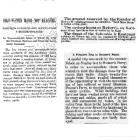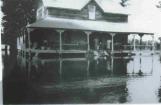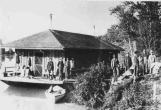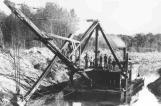1
Disillusioned, William-Adolph Baillie-Grohman abandoned his efforts to reclaim the Kootenay River flats. He sold his interests to the Alberta-British Columbia Exploration Company and returned to Europe.In the fall of 1892, the Alberta-British Columbia Exploration Company launched an ambitious project to prevent the Kootenay's floods by constructing dykes along its banks.
3
The Alberta-British Columbia Exploration Company concentrated its efforts at the very southern end of the Creston Valley, near the Canada-US border. Another Englishman, George Alexander, directed the operations from a floating office barge.Wealthy people in England backed the venture financially, fully expecting to see large returns on their investment when the land was reclaimed and sold.
5
"They began constructing dyke in 1892/93 at the south end of the Reclamation Farm which is across the river going towards Porthill and Rykerts. Compared to the present dykes, a very much lower dyke and narrower in profile. Still, with the equipment available at that time it is amazing what they accomplished.- Bill Constable
The Alberta-British Columbia Exploration Company used a dredge to lift mud and debris from the river bottom, and piled it along the shores of Boundary Creek and the Kootenay River.
7
George Alexander had high hopes for the new dykes, but, "the company had incompetent advice, and poor and insufficent data. In 1894, the run-off was the highest river levels ever recorded."- Bill Constable
The snowfall in the winter of 1893-1894 was unprecedented. The following spring was long and cold. In early June, the temperature rose dramatically, the snowpack in the mountains melted rapidly, and torrential rains fell. The newly-constructed dykes could not withstand the enormous volume of water.
The shores of Kootenay Lake showed the high water mark of 1894 for years after the flood.
8
Newspaper clippings from the Nelson Miner, detailing the flood of 1894.June, 1894
Kootenay Lake, BC

9
"The few miners and prospectors who were residents of the Kootenay Lake country during the summer of 1887 have always taken a certain amount of pleasure in pointing out high-water marks reached by the river that year. Now these marks are either swept away or covered by five feet of water." Nelson Miner, June 9, 1894."Continued warm weather and the large amount of snow in the mountains have caused the outlet at Nelson to rise fully thirty feet above low-water mark." Nelson Miner, June 9, 1894.
"The custom-house at Rykert's, on Kootenay river, has three feet of water on its floor." Nelson Miner, June 2, 1894.
"A special trip was made by the steamer Nelson on Sunday last to Bonner's Ferry. In the valley from there to the head of the lake the river has over-flowed its banks and in places from two to three miles wide. The dyking and other works of the Kootenay Reclamation Company are badly damaged." Nelson Miner, June 1, 1894.
10
The Reclamation farmhouse during the 1920 flood. The Rogers family moved into this house in 1929.1920
Reclamation Farm, near Creston, BC

11
Disheartened but not yet defeated, the Alberta - British Columbia Exploration Company established Reclamation Farm in 1894. It was essentially unprotected by dykes, but crops were grown successfully in the years that the Kootenay River did not flood. In years of high water, though, recalls Margaret Berg who worked on Reclamation Farm, the water would come up to the windows, and everything that could be moved had to be taken upstairs.12
Flood waters at Reclamation Farmhouse, built on the Creston flats in 1895.1920
Reclamation Farm, near Creston, BC

13
"The Reclamation Farmhouse, which was built by the Alberta-BC Exploration Company in 1895 when the first dyking was attempted. The house was torn down in 1946 after being there since 1895. It was a 17-room house, it had a porch on three sides, and was quite a landmark at that time. It was used to house the people that were running the farm and it also housed the people who were doing the various construction and dyking."- Fred Ryckman



